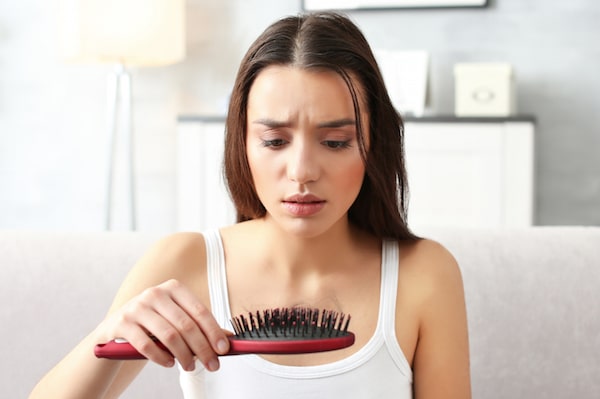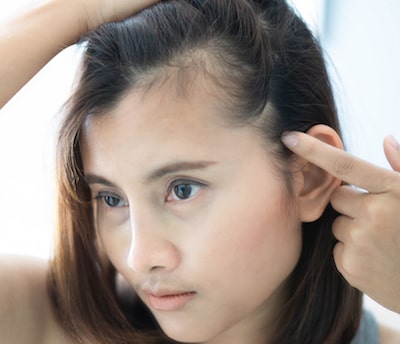Female Hair Loss – Five Effective Treatment Options

The hair on the head has always been a symbol of a person being viewed as youthful and successful. For females, their hair has often represented their level of sexiness in the eyes of others. A full head of hair can make a person feel good about their appearance and give them a healthy self-image as well as confidence and even a sense of style. Unfortunately, many women suffer from hair loss for a variety of reasons. As recently as 2015, the National Institutes of Health reported that around 21-million American women suffered from some form of alopecia. In addition, it was reported that 80% of women experienced a noticeable amount of hair loss by the age of 60. The hair loss suffered by women can have an impact on their self-esteem. Let’s take a look at how hair loss impacts female patients and their treatment options for the hair loss process.
Coping with Female Hair Loss
The process of hair loss can often reduce or eliminate the amount of self-esteem felt by a woman and it can also make her feel less secure about her appearance as well as her sense of style. Self-esteem is linked to how good a person feels about their appearance and often informs how they view their value as a person.
Even though the loss of hair can have a negative impact on the self-esteem of a person, many women know that hair loss might be a possibility for them in the future. They accept hair loss as a natural part of the aging process and embrace their loss of hair on the scalp as a natural part of life. Others look for ways to treat their hair loss or simply decide to get a shorter haircut to try and make the hair loss less noticeable. There are some women that make the choice to wear a wig or some other cover on the head so the hair loss is not visible to others.
Medical Female Hair Loss Treatments
Besides the ideas listed above about wearing the hair in a different style to cover the hair loss, there are multiple medical female hair loss treatments available to patients:
 Minoxidil – The Food and Drug Administration (FDA) has approved minoxidil, AKA Rogaine, for daily use to treat the issue of hair loss. Minoxidil can be purchased over-the-counter and it stimulates the growth of hair as well as causes hair to thicken and reduce any patchy areas of baldness on the scalp. While minoxidil is available in a 2% and 5% solution, studies published in the Journal of the American Academy of Dermatology have shown that 2% minoxidil was effective for the treatment of females with pattern baldness. The medication must be used on a consistent basis because a patient will lose the results gained by minoxidil if the daily usage is stopped by the person.
Minoxidil – The Food and Drug Administration (FDA) has approved minoxidil, AKA Rogaine, for daily use to treat the issue of hair loss. Minoxidil can be purchased over-the-counter and it stimulates the growth of hair as well as causes hair to thicken and reduce any patchy areas of baldness on the scalp. While minoxidil is available in a 2% and 5% solution, studies published in the Journal of the American Academy of Dermatology have shown that 2% minoxidil was effective for the treatment of females with pattern baldness. The medication must be used on a consistent basis because a patient will lose the results gained by minoxidil if the daily usage is stopped by the person.- Ketoconazole – This is a drug that might be able to help hair loss in some cases including androgenetic alopecia (where the inflammation of hair follicles can cause hair loss). There was a review published in the International Journal of Women’s Dermatology that noted that topical ketoconazole could help reduce the inflammation of the hair follicles as well as strengthen the hair. It is available for purchase online, or over the counter, as a shampoo. Patients looking for a stronger concentration of the product will need to get a prescription from a doctor.
- Corticosteroids – There are some female hair loss patients that best respond to an injection of corticosteroids for conditions such as Alopecia Areata where the hair of a person falls out in random patches. While the injections of the corticosteroids into the hairless section might encourage some new growth of hair, there can still be some hair loss in other areas of the scalp.
- Hormone Therapy – Menopause, which is a hormone imbalance, can cause hair loss that might need to be addressed by hormone therapy. Possible treatment options include hormone replacement therapy or birth control pills.
- Hair Transplant – Patients that want to achieve results that are natural and long-lasting in appearance often turn to a hair transplant to gain the desired results. A hair transplant takes hair grafts (usually from the donor area on the back and sides of the scalp) and moves them to the balding area of the scalp. The hair grafts are from an area of the body that is resistant to balding. They act like natural hair once they are placed in the balding area of the scalp.
Female Hair Loss Consultation Appointment
No matter the reason for the hair loss of a female patient (genetics, reaction to medication or an accident or trauma to the scalp), the person suffering from hair loss should schedule a consultation appointment with a board-certified doctor that is experienced in identifying and treating hair loss. The doctor will examine the scalp of the patient to determine the cause of the hair loss and also share the best medical option to treat the hair loss and achieve the final results desired by the patient.
MA